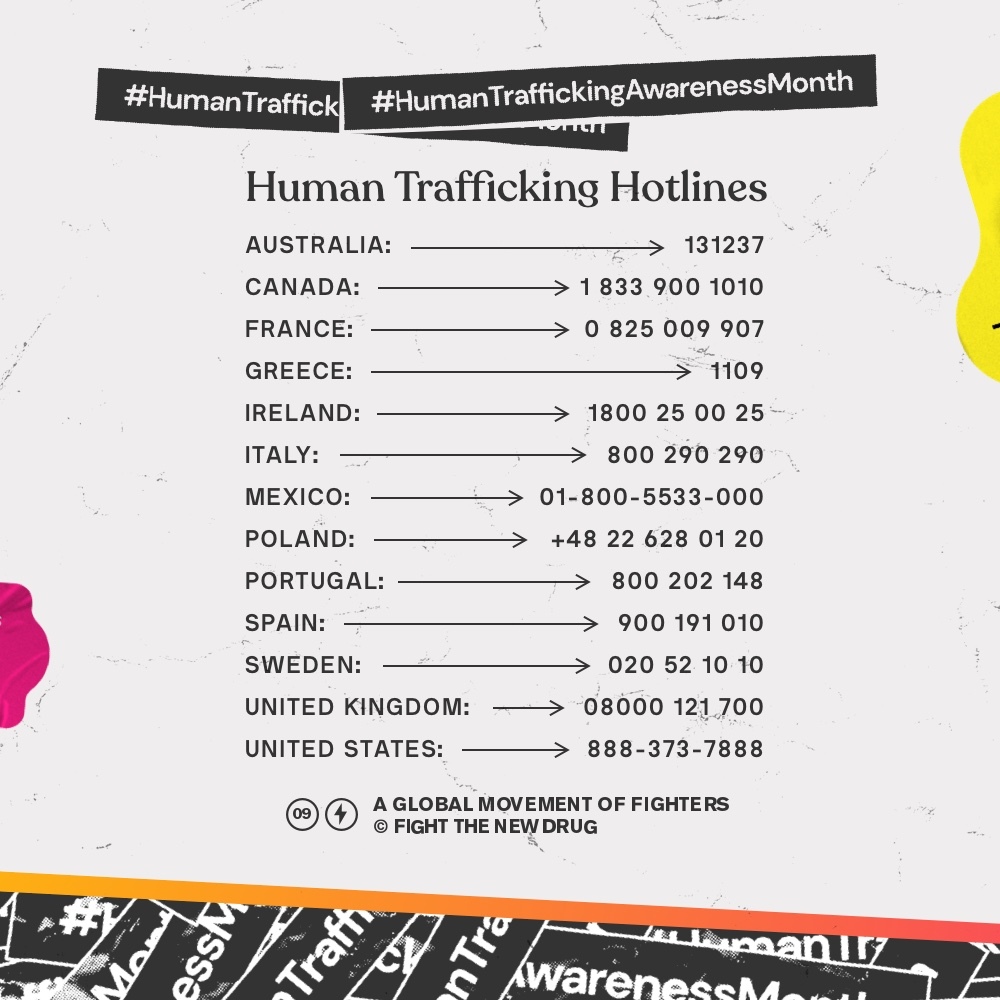When we hear the term “human trafficking,” we often think of movement: a young woman kidnapped, smuggled across borders, and forced into sexual slavery.
This is one sex trafficking scenario, but it’s a myth that it’s the only or most common way.
Sex trafficking is a domestic problem, too. It can happen anywhere, and it does.
In the commercial sex industry, the difference between someone selling sex and sex trafficking is a variety of factors, namely consent. In the United States, the Trafficking Victims Protection Act (TVPA) defines sex trafficking as a situation in which “a commercial sex act is induced by force, fraud, or coercion, or in which the person induced to perform such act has not attained 18 years of age.”
It was sex trafficking when women were lured by porn production company GirlsDoPorn under the guise of a modeling job but forced to perform in porn. It’s sex trafficking when a teenager is sold online by her new “boyfriend” for live performances. It is sex trafficking when an already-established porn performer is coerced into doing sex acts on camera they don’t want to do. These are just a few examples and scenarios beyond the Hollywood plotline we imagine.
Just as much as there are misconceptions about how sex trafficking happens, there is a long-standing myth that we can’t fix the problem. This is an assumption one researcher, Dr. Michael Shively, Senior Advisor on Research and Data Analysis at the U.S. based National Center on Sexual Exploitation (NCOSE), refuses to accept.
We recently spoke with Dr. Shively to myth-bust persisting ideas about trafficking and to better understand how we can stop the demand.
Economics 101: supply and demand
As the saying goes, selling sex is one of the “oldest professions.” It has stood the test of time, implying that commercialized sex is inevitable, but the problem with the status quo is, as Dr. Shively said, “Anywhere there is commercial sex, there is trafficking.”
This is not to say that all commercial sex involves trafficking 100% of the time. However, where sex is sold, coercion can follow.
Commercial sex is a market, and basic economic principles tell us that where there is demand, supply will follow. In other words, because people are willing to buy sex, traffickers see an opportunity to make money and supply victims—women, girls, boys, and even men—for a price.
“Sex traffickers are motivated by one thing,” Dr. Shively said. “They are trying to make money. It’s a market, a business, and the commodity is people. You only generate the supply—the people—if there is demand, and without demand, there is no motivation to come up with that supply.”
Today, a lot of the efforts to fight sex trafficking focus on rescuing victims and bringing traffickers to justice. This is important work that needs to continue. These efforts suppress trafficking, but unfortunately, only temporarily. Another trafficker will come along and fill that space because there is still money to be made, and buyers are willing to pay. According to Shively, the key to fighting trafficking is fighting demand.
“For the vast majority of human history, the thing that has been ignored or underemphasized more than any other aspect is the buyers,” he said.
No buyers, no business
While sex traffickers are predominately motivated by money, buyer motivations are all over the map. There are dozens of reasons men, the most predominant buyers, give when surveyed about why they purchased sex, which can be grouped into common threads.
Some wish they were in a relationship; others are the opposite and don’t want a relationship at all, just sex. Some are thrill-seeking, others have particular interests, fetishes, or want the experience of having sex with different types of people.
Many sex buyers are men who may not be aware of or sensitive to the consequences of their actions. They are looking to get a need met. Do not intend to cause harm. They also believe the women they are buying sex from are in the industry voluntarily.
In recent years, there have been more efforts to educate buyers and influence their behaviors away from purchasing sex.
One example is the First Offender Prostitution Program implemented in San Francisco. It was a one-day education program, sometimes colloquially known as a “john school,” for first-time arrested sex buyers who had the option to pay to attend the program or be prosecuted. In 2008, Shively conducted a study looking at the program’s effectiveness. He and his research team analyzed recidivism rates throughout California. They looked for a second arrest for sex buying. This was done in the ten years before and ten years after the education program.
Shively didn’t expect the program to create lasting change. Changing behaviors is challenging, and buyers have varied motivations. How can a single program on commercial sex and trafficking make a difference? When Shively saw the numbers, he was shocked.
The results revealed that the regular rearrest rate was 8.8%. This rate dropped to 4.5% the year the education program began and remained low afterward. In other words, reoffending rates dropped by 40%. The program seemed to be successful in changing buyer behaviors.
“We have been trained to call it the oldest profession, to think of it as something natural. Sex is natural, but we aren’t talking about that. We are talking about turning sex into commerce,” Dr. Shively said. “We don’t turn everything into commerce because we know bad things happen when you do. We don’t allow adoption to become a business where you can buy a kid. We don’t allow kidneys to become a commodity because we know they set up profit motivations that will make bad things happen. When you commodify sex, you commodify access to women, girls, and also boys.”
Fighting sex trafficking needs a multi-faceted solution. Shively said we must continue to rescue victims. We must hold traffickers accountable. However, we cannot ignore the buyers. We must also address cultural influences that encourage trafficking.
Pornified culture and the links to sex trafficking
The sale of sex is not inevitable, nor is it necessary to feed the sexual needs of buyers. Instead, it can be viewed as a product of a culture that encourages entitlement to another person’s body for pleasure.
If that sounds familiar, it is because this is one of the messages porn sells. Porn portrays women, especially, as available and always eager to engage in sex. There is a distinct lack of consent. Instead, videos generally show women acting like they enjoy rough or violent counters, extreme acts, and even domination.
A person with good intentions might view porn and believe the acts depicted are always wanted without checking for consent. Consumers may start to feel that they are right to want the things they have seen in porn because porn is a common (but deeply flawed) sex educator.
“The evidence is showing up fast and furious now,” Dr. Shively said. “Anyone with a gut feeling, moral code, or anything that would make them suspicious of pornography, well, you can prove it now. It’s becoming a public health concern. Addictions are being created. Adolescent and child brains are being rewired because of the content that is so accessible.”
Not everyone who consumes porn will believe it’s acceptable to buy sex. Yet we cannot ignore the research that shows porn consumption to be an escalating behavior and the stories of men who decided porn wasn’t enough and turned to purchasing sex in reality to fulfill a fantasy.
While no issue can be completely eliminated, constant advocacy work is still worthwhile and important, don’t you think?
Homicides are still committed, and yet our society fights against that behavior. Cures for a variety of illnesses still elude doctors, but they continue to search for solutions. The same should be true for sex trafficking: it takes effort on all sides to make a difference.
We can rescue victims, bring justice to traffickers, hold buyers to account, and finally, reject porn with its messages of sexual entitlement that fuel the demand for exploitation.

Your Support Matters Now More Than Ever
Most kids today are exposed to porn by the age of 12. By the time they’re teenagers, 75% of boys and 70% of girls have already viewed itRobb, M.B., & Mann, S. (2023). Teens and pornography. San Francisco, CA: Common Sense.Copy —often before they’ve had a single healthy conversation about it.
Even more concerning: over half of boys and nearly 40% of girls believe porn is a realistic depiction of sexMartellozzo, E., Monaghan, A., Adler, J. R., Davidson, J., Leyva, R., & Horvath, M. A. H. (2016). “I wasn’t sure it was normal to watch it”: A quantitative and qualitative examination of the impact of online pornography on the values, attitudes, beliefs and behaviours of children and young people. Middlesex University, NSPCC, & Office of the Children’s Commissioner.Copy . And among teens who have seen porn, more than 79% of teens use it to learn how to have sexRobb, M.B., & Mann, S. (2023). Teens and pornography. San Francisco, CA: Common Sense.Copy . That means millions of young people are getting sex ed from violent, degrading content, which becomes their baseline understanding of intimacy. Out of the most popular porn, 33%-88% of videos contain physical aggression and nonconsensual violence-related themesFritz, N., Malic, V., Paul, B., & Zhou, Y. (2020). A descriptive analysis of the types, targets, and relative frequency of aggression in mainstream pornography. Archives of Sexual Behavior, 49(8), 3041-3053. doi:10.1007/s10508-020-01773-0Copy Bridges et al., 2010, “Aggression and Sexual Behavior in Best-Selling Pornography Videos: A Content Analysis,” Violence Against Women.Copy .
From increasing rates of loneliness, depression, and self-doubt, to distorted views of sex, reduced relationship satisfaction, and riskier sexual behavior among teens, porn is impacting individuals, relationships, and society worldwideFight the New Drug. (2024, May). Get the Facts (Series of web articles). Fight the New Drug.Copy .
This is why Fight the New Drug exists—but we can’t do it without you.
Your donation directly fuels the creation of new educational resources, including our awareness-raising videos, podcasts, research-driven articles, engaging school presentations, and digital tools that reach youth where they are: online and in school. It equips individuals, parents, educators, and youth with trustworthy resources to start the conversation.
Will you join us? We’re grateful for whatever you can give—but a recurring donation makes the biggest difference. Every dollar directly supports our vital work, and every individual we reach decreases sexual exploitation. Let’s fight for real love:




